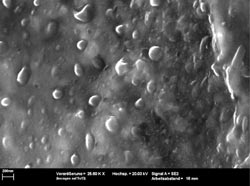Self-healing surfaces

The nano-capsules in the electroplated layer contain a fluid. If the layer is scratched, the layers burst, the fluid escapes and repairs the scratch. Credit: Fraunhofer IPA
It's a different matter with materials, such as metals – if the electroplated layer protecting the metals from corrosion is scratched, rust protection is lost. Engineers are working on transferring the self-healing effect of skin to materials.
The idea behind this is to introduce evenly distributed fluid-filled capsules into the electroplated layer – rather like raisins in a cake. If the layer is damaged, the pellets at the point of damage burst, the fluid runs out and 'repairs' the scratch. Until now, these plans have failed due to the size of the capsules – at 10 to 15 micrometers they were too large for the electroplated layer, which is around 20 micrometers thick. The capsules altered the mechanical properties of the layer.
Researchers from the Fraunhofer Institute for Manufacturing Engineering and Automation IPA in Stuttgart, together with colleagues from Duisburg-Essen University, have developed a process for producing electroplated layers with nano-capsules, in a project being financed by the Volkswagen Foundation. At only a few hundred nanometers in diameter, the capsules are measured on another scale entirely, compared with previous results.
“The challenge lies in not damaging the capsules when producing the electroplated layer”, says Dr. Martin Metzner, Head of Department at IPA. “The smaller the capsules, the thinner and more sensitive their casing. The electrolytes used for these electroplated-technical processes are extremely aggressive chemically and can easily destroy the capsules”. The researchers therefore had to find a compatible material for the capsule casing depending on the electrolytes used.
Mechanical bearings are one example of possible applications – the materials of the bearings usually have a electroplated coating, in which the capsules can be embedded. If there is a temporary shortage of lubricant, part of the bearing's coating is lost, the capsules at the top of the layer burst and release lubricant.
The bearing is not therefore damaged if it temporarily runs dry. The researchers have produced the first copper, nickel and zinc coatings with the new capsules, although surface coverage does not extend beyond the centimeter scale. Experts estimate that it will be another one and a half to two years before whole components can be coated. In a further step the team worked on more complex systems – involving differently filled capsules, for example, whose fluids react with one another like a two component adhesive.
Media Contact
More Information:
http://www.ipa.fraunhofer.deAll latest news from the category: Materials Sciences
Materials management deals with the research, development, manufacturing and processing of raw and industrial materials. Key aspects here are biological and medical issues, which play an increasingly important role in this field.
innovations-report offers in-depth articles related to the development and application of materials and the structure and properties of new materials.
Newest articles

Properties of new materials for microchips
… can now be measured well. Reseachers of Delft University of Technology demonstrated measuring performance properties of ultrathin silicon membranes. Making ever smaller and more powerful chips requires new ultrathin…

Floating solar’s potential
… to support sustainable development by addressing climate, water, and energy goals holistically. A new study published this week in Nature Energy raises the potential for floating solar photovoltaics (FPV)…

Skyrmions move at record speeds
… a step towards the computing of the future. An international research team led by scientists from the CNRS1 has discovered that the magnetic nanobubbles2 known as skyrmions can be…





















